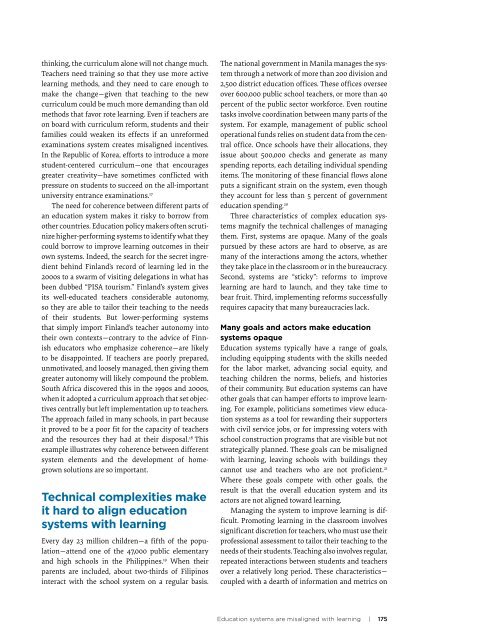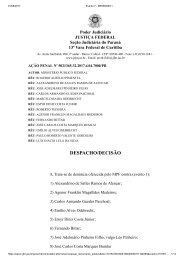Brasil só deve dominar Leitura em 260 anos, aponta estudo do Banco Mundial Relatorio Banco Mundial _Learning
Create successful ePaper yourself
Turn your PDF publications into a flip-book with our unique Google optimized e-Paper software.
thinking, the curriculum alone will not change much.<br />
Teachers need training so that they use more active<br />
learning methods, and they need to care enough to<br />
make the change—given that teaching to the new<br />
curriculum could be much more d<strong>em</strong>anding than old<br />
methods that favor rote learning. Even if teachers are<br />
on board with curriculum reform, students and their<br />
families could weaken its effects if an unreformed<br />
examinations syst<strong>em</strong> creates misaligned incentives.<br />
In the Republic of Korea, efforts to introduce a more<br />
student-centered curriculum—one that encourages<br />
greater creativity—have sometimes conflicted with<br />
pressure on students to succeed on the all-important<br />
university entrance examinations. 17<br />
The need for coherence between different parts of<br />
an education syst<strong>em</strong> makes it risky to borrow from<br />
other countries. Education policy makers often scrutinize<br />
higher-performing syst<strong>em</strong>s to identify what they<br />
could borrow to improve learning outcomes in their<br />
own syst<strong>em</strong>s. Indeed, the search for the secret ingredient<br />
behind Finland’s record of learning led in the<br />
2000s to a swarm of visiting delegations in what has<br />
been dubbed “PISA tourism.” Finland’s syst<strong>em</strong> gives<br />
its well-educated teachers considerable autonomy,<br />
so they are able to tailor their teaching to the needs<br />
of their students. But lower-performing syst<strong>em</strong>s<br />
that simply import Finland’s teacher autonomy into<br />
their own contexts—contrary to the advice of Finnish<br />
educators who <strong>em</strong>phasize coherence—are likely<br />
to be disappointed. If teachers are poorly prepared,<br />
unmotivated, and loosely managed, then giving th<strong>em</strong><br />
greater autonomy will likely compound the probl<strong>em</strong>.<br />
South Africa discovered this in the 1990s and 2000s,<br />
when it a<strong>do</strong>pted a curriculum approach that set objectives<br />
centrally but left impl<strong>em</strong>entation up to teachers.<br />
The approach failed in many schools, in part because<br />
it proved to be a poor fit for the capacity of teachers<br />
and the resources they had at their disposal. 18 This<br />
example illustrates why coherence between different<br />
syst<strong>em</strong> el<strong>em</strong>ents and the <strong>deve</strong>lopment of homegrown<br />
solutions are so important.<br />
Technical complexities make<br />
it hard to align education<br />
syst<strong>em</strong>s with learning<br />
Every day 23 million children—a fifth of the population—attend<br />
one of the 47,000 public el<strong>em</strong>entary<br />
and high schools in the Philippines. 19 When their<br />
parents are included, about two-thirds of Filipinos<br />
interact with the school syst<strong>em</strong> on a regular basis.<br />
The national government in Manila manages the syst<strong>em</strong><br />
through a network of more than 200 division and<br />
2,500 district education offices. These offices oversee<br />
over 600,000 public school teachers, or more than 40<br />
percent of the public sector workforce. Even routine<br />
tasks involve coordination between many parts of the<br />
syst<strong>em</strong>. For example, manag<strong>em</strong>ent of public school<br />
operational funds relies on student data from the central<br />
office. Once schools have their allocations, they<br />
issue about 500,000 checks and generate as many<br />
spending reports, each detailing individual spending<br />
it<strong>em</strong>s. The monitoring of these financial flows alone<br />
puts a significant strain on the syst<strong>em</strong>, even though<br />
they account for less than 5 percent of government<br />
education spending. 20<br />
Three characteristics of complex education syst<strong>em</strong>s<br />
magnify the technical challenges of managing<br />
th<strong>em</strong>. First, syst<strong>em</strong>s are opaque. Many of the goals<br />
pursued by these actors are hard to observe, as are<br />
many of the interactions among the actors, whether<br />
they take place in the classroom or in the bureaucracy.<br />
Second, syst<strong>em</strong>s are “sticky”: reforms to improve<br />
learning are hard to launch, and they take time to<br />
bear fruit. Third, impl<strong>em</strong>enting reforms successfully<br />
requires capacity that many bureaucracies lack.<br />
Many goals and actors make education<br />
syst<strong>em</strong>s opaque<br />
Education syst<strong>em</strong>s typically have a range of goals,<br />
including equipping students with the skills needed<br />
for the labor market, advancing social equity, and<br />
teaching children the norms, beliefs, and histories<br />
of their community. But education syst<strong>em</strong>s can have<br />
other goals that can hamper efforts to improve learning.<br />
For example, politicians sometimes view education<br />
syst<strong>em</strong>s as a tool for rewarding their supporters<br />
with civil service jobs, or for impressing voters with<br />
school construction programs that are visible but not<br />
strategically planned. These goals can be misaligned<br />
with learning, leaving schools with buildings they<br />
cannot use and teachers who are not proficient. 21<br />
Where these goals compete with other goals, the<br />
result is that the overall education syst<strong>em</strong> and its<br />
actors are not aligned toward learning.<br />
Managing the syst<strong>em</strong> to improve learning is difficult.<br />
Promoting learning in the classroom involves<br />
significant discretion for teachers, who must use their<br />
professional assessment to tailor their teaching to the<br />
needs of their students. Teaching also involves regular,<br />
repeated interactions between students and teachers<br />
over a relatively long period. These characteristics—<br />
coupled with a dearth of information and metrics on<br />
Education syst<strong>em</strong>s are misaligned with learning | 175








